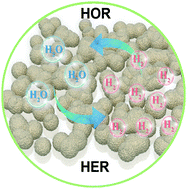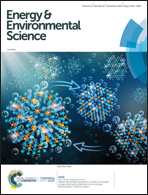Weakening hydrogen adsorption on nickel via interstitial nitrogen doping promotes bifunctional hydrogen electrocatalysis in alkaline solution†
Abstract
Ni-Based materials are promising candidates for the electrocatalytic hydrogen oxidation reaction and hydrogen evolution reaction in alkaline solution. However, pure Ni binds hydrogen very strongly. To promote its electrocatalytic activity would require the weakening of its hydrogen binding energy. Here, we demonstrate that interstitial nitrogen doping in Ni3N can greatly promote its electrocatalytic activity. Ni3N nanoparticles are prepared from the controlled nitridation of Ni-based coordination polymer nanosheets. The resultant product exhibits excellent mass activity superior to most existing non-precious-metal-based materials and great CO-tolerance for the hydrogen oxidation reaction, as well as remarkable activity and stability for the hydrogen evolution reaction. Our experimental results are further understood and supported by theoretical simulations showing that the interstitial nitrogen doping significantly decreases the hydrogen binding energy and lowers the activation barrier for water formation and dissociation.



 Please wait while we load your content...
Please wait while we load your content...